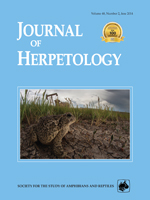To understand the seasonal reproductive dynamics of Hypsiboas albopunctatus, a Neotropical treefrog, we studied the following components: 1) the influence of abiotic factors on seasonality, 2) how this seasonality relates to population dynamics, and 3) male breeding recruitment. We conducted fieldwork every month from August 2007 to July 2008 within an ecotone connecting semideciduous Atlantic Forest and Cerrado (Brazilian Savanna) in São Paulo State, southeastern Brazil. Over the course of the prolonged breeding season, we recorded the maximum number of calling males and measured their snout–vent lengths; we then compared our data from the beginning and the end of the breeding season. We found that the breeding pattern of H. albopunctatus is correlated with climatic, physical, and biological factors. Male competition and aggression varied according to the population density, most likely as a function of resource availability. There appears to be a social hierarchy among males of H. albopunctatus according to body size. Large calling males dominated the chorus in the beginning of the breeding season, but smaller males contributed more to the assemblage as the breeding season progressed. The average size of calling males at the end of the breeding season was significantly smaller. Smaller males occurred most in January and February, marking the H. albopunctatus breeding recruitment, when an abundance of adequate breeding microhabitats exist. Our full-season study serves as a cautionary tale: hypotheses based on body size, particularly for prolonged anuran breeder species, may be affected by seasonality.
How to translate text using browser tools
1 June 2014
Reproductive Dynamics of the Neotropical Treefrog Hypsiboas albopunctatus (Anura, Hylidae)
Fábio P. de Sá,
Juliana Zina,
Célio F. B. Haddad
ACCESS THE FULL ARTICLE

Journal of Herpetology
Vol. 48 • No. 2
June 2014
Vol. 48 • No. 2
June 2014





